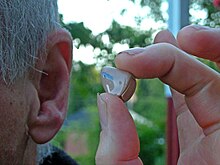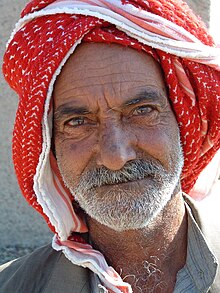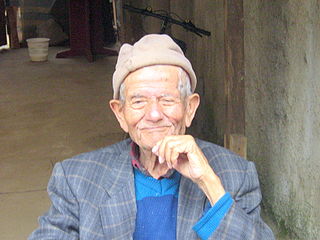
Old age is the range of ages for people nearing and surpassing life expectancy. People of old age are also referred to as: old people, elderly, elders, senior citizens, seniors or older adults. Old age is not a definite biological stage: the chronological age denoted as "old age" varies culturally and historically. Some disciplines and domains focus on the aging and the aged, such as the organic processes of aging (senescence), medical studies of the aging process (gerontology), diseases that afflict older adults (geriatrics), technology to support the aging society (gerontechnology), and leisure and sport activities adapted to older people.

Gerontology is the study of the social, cultural, psychological, cognitive, and biological aspects of aging. The word was coined by Ilya Ilyich Mechnikov in 1903, from the Greek γέρων (gérōn), meaning "old man", and -λογία (-logía), meaning "study of". The field is distinguished from geriatrics, which is the branch of medicine that specializes in the treatment of existing disease in older adults. Gerontologists include researchers and practitioners in the fields of biology, nursing, medicine, criminology, dentistry, social work, physical and occupational therapy, psychology, psychiatry, sociology, economics, political science, architecture, geography, pharmacy, public health, housing, and anthropology.

Geriatrics, or geriatric medicine, is a medical specialty focused on providing care for the unique health needs of the elderly. The term geriatrics originates from the Greek γέρων geron meaning "old man", and ιατρός iatros meaning "healer". It aims to promote health by preventing, diagnosing and treating disease in older adults. There is no defined age at which patients may be under the care of a geriatrician, or geriatric physician, a physician who specializes in the care of older people. Rather, this decision is guided by individual patient need and the caregiving structures available to them. This care may benefit those who are managing multiple chronic conditions or experiencing significant age-related complications that threaten quality of daily life. Geriatric care may be indicated if caregiving responsibilities become increasingly stressful or medically complex for family and caregivers to manage independently.

Population ageing is an increasing median age in a population because of declining fertility rates and rising life expectancy. Most countries have rising life expectancy and an ageing population, trends that emerged first in developed countries but are now seen in virtually all developing countries. In most developed countries, the phenomenon of population aging began to gradually emerge in the late 19th century. The aging of the world population occurred in the late 20th century, with the proportion of people aged 65 and above accounting for 6% of the total population. This reflects the overall decline in the world's fertility rate at that time. That is the case for every country in the world except the 18 countries designated as "demographic outliers" by the United Nations. The aged population is currently at its highest level in human history. The UN predicts the rate of population ageing in the 21st century will exceed that of the previous century. The number of people aged 60 years and over has tripled since 1950 and reached 600 million in 2000 and surpassed 700 million in 2006. It is projected that the combined senior and geriatric population will reach 2.1 billion by 2050. Countries vary significantly in terms of the degree and pace of ageing, and the UN expects populations that began ageing later will have less time to adapt to its implications.
Reminiscence is the act of recollecting past experiences or events. An example of the typical use of reminiscence is when people share their personal stories with others or allows other people to live vicariously through stories of family, friends, and acquaintances while gaining an authentic meaningful relationship with the people. An example of reminiscence may be grandparents remembering past events with friends or their grandchildren, sharing their individual experience of what the past was like.
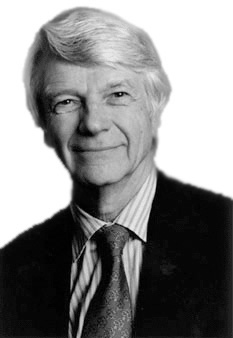
Robert Neil Butler was an American physician, gerontologist, psychiatrist, and author, who was the first director of the National Institute on Aging. Butler is known for his work on the social needs and the rights of the elderly and for his research on healthy aging and the dementias.
Program of All-inclusive Care for the Elderly (PACE) are programs within the United States that provide comprehensive health services for individuals age 55 and over who are sufficiently frail to be categorized as "nursing home eligible" by their state's Medicaid program. The ultimate goal of PACE programs is to keep eligible older adults out of nursing homes and within their communities for as long as possible. Services include primary and specialty medical care, nursing, nutrition, social services, therapies, pharmaceuticals, day health center services, home care, health-related transportation, minor modification to the home to accommodate disabilities, and anything else the program determines is medically necessary to maximize a member's health. If you or a loved one are eligible for nursing home level care but prefer to continue living at home, a PACE program can provide expansive health care and social opportunities during the day while you retain the comfort and familiarity of your home outside of day hours.

The disengagement theory of ageing states that "aging is an inevitable, mutual withdrawal or disengagement, resulting in decreased interaction between the aging person and others in the social system he belongs to". The theory claims that it is natural and acceptable for older adults to withdraw from society. There are multiple variations on disengagement theory, such as moral disengagement.
Eileen M. Crimmins is the AARP Chair in Gerontology at the USC Davis School of Gerontology of the University of Southern California. Her work focuses on the connections between socioeconomic factors and life expectancy and other health outcomes.
Adult development encompasses the changes that occur in biological and psychological domains of human life from the end of adolescence until the end of one's life. Changes occur at the cellular level and are partially explained by biological theories of adult development and aging. Biological changes influence psychological and interpersonal/social developmental changes, which are often described by stage theories of human development. Stage theories typically focus on "age-appropriate" developmental tasks to be achieved at each stage. Erik Erikson and Carl Jung proposed stage theories of human development that encompass the entire life span, and emphasized the potential for positive change very late in life.

Reminiscence therapy is used to counsel and support older people, and is an intervention technique with brain-injured patients and those who appear to have "Alzheimer's and other forms of cognitive disease."
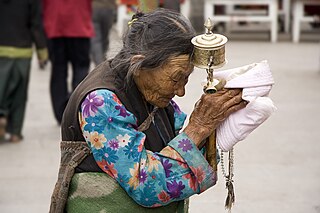
The continuity theory of normal aging states that older adults will usually maintain the same activities, behaviors, relationships as they did in their earlier years of life. According to this theory, older adults try to maintain this continuity of lifestyle by adapting strategies that are connected to their past experiences.
Ageing is the process of becoming older. The term refers mainly to humans, many other animals, and fungi, whereas for example, bacteria, perennial plants and some simple animals are potentially biologically immortal. In a broader sense, ageing can refer to single cells within an organism which have ceased dividing, or to the population of a species.

The activity theory of aging, also known as the implicit theory of aging, normal theory of aging, and lay theory of aging, proposes that aging occurs with more positive outcomes when adults stay active and maintain social interactions as they get older. Activity theory suggests that the aging process is slowed or delayed, and quality of life is enhanced when the elderly remain socially active. Book clubs, club sports, barbeques, volunteer work, fitness classes, brunch dates, holiday celebrations and protests are just a few examples of how people maintain a healthy social life, which the activity theory of aging reports contributes to overall health in later life.
Becca R. Levy is a professor of Epidemiology at Yale School of Public Health and Professor of Psychology at Yale University. She is a leading researcher in the fields of social gerontology and psychology of aging. She is credited with creating the field of how age stereotypes, which are assimilated from the culture, impact the health of older individuals. The Dean of Columbia School of Public Health describes Levy as "a pioneer" in the "growing body of impressive research showing that our attitudes toward aging affect our health, our resilience in the face of adversity, and our very survival."
Cumulative inequality theory or cumulative disadvantage theory is the systematic explanation of how inequalities develop. The theory was initially developed by Merton in 1988, who studied the sciences and prestige. He believed that recognition from peers, and from published research in the scientific field created cumulative advantage or also Matthew effect that led to the receipt of resources that facilitated research projects. The theory expanded in four decades to include the idea that some people have more disadvantages than advantages which influence the quality of life of societies, cohorts, and individuals. The theory is principally a social scientific explanation of phenomena but with links to biological and health factors, personal adjustment, and well-being. A central premise is that "social systems generate inequality, which is manifested over the life course via demographic and developmental processes." Cumulative inequality and cumulative advantage/disadvantage (CAD) are two different but interrelated theories. Cumulative inequality has drawn from various theoretical traditions, including CAD.
Research into food preferences in older adults and seniors considers how people's dietary experiences change with ageing, and helps people understand how taste, nutrition, and food choices can change throughout one's lifetime, particularly when people approach the age of 70 or beyond. Influencing variables can include: social and cultural environment, gender and/or personal habits, and also physical and mental health. Scientific studies have been performed to explain why people like or dislike certain foods and what factors may affect these preferences.
Elder rights are the rights of older adults, who in various countries are not recognized as a constitutionally protected class, yet face discrimination across many aspects of society due to their age.
Karl Andrew Pillemer is an American sociologist and gerontologist who is the Hazel E. Reed Professor of Human Development at Cornell University, and Professor of Gerontology in Medicine at Weill Cornell Medicine. His research focuses on intergenerational relations in later life, long-term care for frail and disabled older persons, and social engagement and involvement of older persons. Pillemer is the founder of the Cornell Legacy Project, which since 2004 has collected accounts of the life wisdom of over 2,000 older Americans, and the Cornell Family Reconciliation Project, which researches family estrangement.
Jiska Cohen-Mansfield is the Igor Orenstein Chair for the Study of Geriatrics at Tel Aviv University Medical School and a professor at the Department of Health Promotion at the School of Public Health in the Sackler Medical Faculty at Tel Aviv University. She is the director of the Minerva Center for Interdisciplinary Study of End of Life at Tel-Aviv University.




